|
Kids
and Youth
Introduction
In the last half of 2000, Latin America and the Caribbean were not
severely affected by hydrometeorological, seismic, environmental or technological
emergencies. One possible exception was the eruption of the Popocatépetl
volcano in Mexico.
Accordingly, we are going to use the Disasters in the Region section
to present the following article, which is directed at children and the
young, and written in a didactic manner that makes it ideal for use in
the classroom. It is an excellent example of what this year’s World
Disaster Reduction Campaign is all about: Disaster Reduction, Education
and Youth.
After
a Disaster: How to Help Child Victims
The following information is taken from the web site of the Federal Emergency
Management Agency of the United States of America (FEMA) in their place
FEMA KIDS
http://www.fema.gov/library/e_child.htm
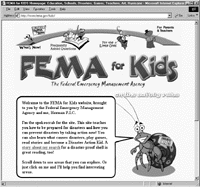 Children
who experience an initial traumatic event before they are 11 years old
are three times more likely to develop psychological symptoms than those
who experience their first trauma as a teenager or later. But children
are able to cope better with a traumatic event if parents, friends, family,
teachers and other adults support and help them with their experiences.
Help should start as soon as possible after the event. Children
who experience an initial traumatic event before they are 11 years old
are three times more likely to develop psychological symptoms than those
who experience their first trauma as a teenager or later. But children
are able to cope better with a traumatic event if parents, friends, family,
teachers and other adults support and help them with their experiences.
Help should start as soon as possible after the event.
It’s important
to remember that some children may never show distress because they don’t
feel upset, while others may not give evidence of being upset for several
weeks or even months. Other children may not show a change in behavior,
but may still need your help.
Children may exhibit
these behaviors after a disaster:
- Be upset over
the loss of a favorite toy, blanket, teddy bear or other times that
adults might consider insignificant, but which are important to the
child.
- Change from being
quiet, obedient and caring to loud, noisy and aggressive or may change
from being outgoing to shy and afraid.
- Develop nighttime
fears. They may be afraid to sleep alone at night, with the light off,
to sleep in their own room, or have nightmares or bad dreams.
- Be afraid the
event will reoccur.
- Become easily
upset, crying and whining.
- Lose trust in
adults. After all, their adults were not able to control the disaster.
- Revert to younger
behavior such as bed wetting and thumb sucking.
- Not want parents
out of their sight and refuse to go to school or childcare.
- Feel guilty that
they caused the disaster because of something they had said or done.
- Become afraid
of wind, rain or sudden loud noises.
- Have symptoms
of illness, such as headaches, vomiting or fever.
- Worry about where
they and their family will live.
Things Parents
or Other Caring Adults Can Do
- Talk with the
children about how they are feeling and listen without judgment. Let
them know they can have own feelings, which might be different than
others. It’s OK.
- Let the children
take their time to figure things out and to have their feelings. Don’t
rush them or pretend that they don’t think or feel as they do.
- Help them learn
to use words that express their feelings, such as happy, sad, angry,
mad and scared. Just be sure the words fit their feelings - not yours.
- Assure fearful
children that you will be there to take care of them. Reassure them
many times.
- Stay together
as a family as much as possible.
- Go back as soon
as possible to former routines or develop new ones. Maintain a regular
schedule for the children.
- Reassure the children
that the disaster was not their fault in any way.
- Let them have
some control, such as choosing what outfit to wear or what meal to have
for dinner.
- Help your children
know that others love them and care about them by visiting, talking
on the phone or writing to family members, friends and neighbors.
- Encourage the
children to give or send pictures they have drawn or things they have
written.
- Re-establish contact
with extended family members.
- Help your children
learn to trust adults again by keeping promises, including children
in planning routines and outings.
- Help your children
regain faith in the future by helping them develop plans for activities
that will take place later - next week, next month.
- Children cope
better when they are healthy, so be sure your children get needed healthcare
as soon as possible.
- Make sure the
children are getting balanced meals and eating enough food and getting
enough rest.
- Remember to take
care of yourself so you can take care of your children.
- Spend extra time
with your children at bedtime. Read stories, rub their backs, listen
to music, talk quietly about the day.
- If you will be
away for a time, tell them where you are going and make sure you return
or call at the time you say you will.
- Allow special
privileges such as leaving the light on when they sleep for a period
of time after the disaster.
- Limit their exposure
to additional trauma, including news reports.
- Children should
not be expected to be brave or tough, or to “not cry.”
- Don’t be
afraid to “spoil” children in this period after a disaster.
- Don’t give
children more information than they can handle about the disaster.
- Don’t minimize
the event.
- Find ways to emphasize
to the children that you love them.
- Allow the children
to grieve losses.
- Develop positive
anniversary activities to commemorate the event. These events may bring
tears, but they are also a time to celebrate survival and the ability
to get back to a normal life.
|
Activities
for Children: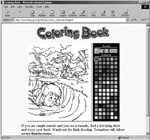
- Encourage the children to draw or paint pictures of how they
feel about their experiences. Hang these at the child’s level
to be seen easily.
-
Write a story of the frightening event. You might start with:
Once upon a time there was a terrible ___________ and it scared
us all ____________. This is what happened: __________. Be sure
to end with “And we are now safe.”
-
Playing with playdough or clay is good for children to release
tension and make symbolic creations.
-
Music is fun and valuable for children. Creating music with
instruments or rhythm toys helps relieve stress and tension.
-
Provide the children with clothes, shoes, hats, etc. so they
can play “dress up” and can pretend to be adults in
charge of recovering from the disaster and “being in charge.”
-
Make puppets with the children and put on a puppet show for
family and friends, or help children put on a skit about what
they experienced.
-
Read stories about disasters to and with children.
|
This information is provided by Beryl Cheal, an educator with
Disaster Training International, P.O. Box 30144, Seattle, WA 98103
Tel. (1-206) 781-0701, http://www.fema.gov/library/e_child.htm
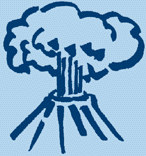
Volcanoes
Jaquelina
Michienzi
Senior Meteorologist
The Weather Channel Latin America
What is a volcano?
It is an elevation on the surface of the Earth through which magma, associated
gases, and ashes erupt; it is also the form or structure (usually conic)
that is produced by the material ejected. The word “volcano”
comes from Vulcan, who was the Roman god of fire.
Structure of a
volcano
It is made up mostly of:
A magma chamber
located several kilometers underground. It is usually thought of as having
large dimensions, and it is believed that it is responsible, though not
always, for the collapse of the cone structure of many volcanoes. When
the chamber is left nearly empty after ejecting all of its content into
the surface, the volcano loses stability and a part collapses under its
own weight.
A pipe, which
is the channel through which magma reaches the surface.
A cone, which
is the visible part of a volcano, and is produced by layers of all the
volcanic materials ejected through the pipe over many eruptions and years.
A volcano is young when the cone is in perfect shape; an older volcano’s
cone has often been destroyed by previous eruptions as well as atmospheric
phenomena such as rain, wind, and the effect of glaciers. Volcanoes with
very wrecked cones have erupted again after many years of inactivity.
A crater is
the hole through which the magma is expelled, and it is on top of the
volcano. The crater may be from a few hundred meters to several kilometers
wide. When the cone of a volcano collapses, it forms a wider crater that
is known as a cauldron.
What are the effects of volcanic ash on health?
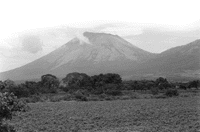 One
of the hazards caused by volcanic eruptions is the expulsion of ash, among
other elements. It is worth knowing something about it, so as not to be
frightened if we should be exposed to it by being in an affected area,
whether we live there or are there as tourists. One
of the hazards caused by volcanic eruptions is the expulsion of ash, among
other elements. It is worth knowing something about it, so as not to be
frightened if we should be exposed to it by being in an affected area,
whether we live there or are there as tourists.
- Depending on its
components, volcanic ash can be very damaging to human health.
- Inhaling the ash
can worsen lung diseases, asthma, and silicosis.
- It can cause stomach
troubles due to drinking water contaminated with fluoride and possibly
heavy metals such as arsenic or mercury. Food can also be contaminated,
which is why experts recommend that water deposits and the food that
is prepared and eaten in the open air be covered.
- Damage may also
be caused to the eyes, such as conjunctivitis and abrasions of the cornea.
- Since the gases
retained by ash are released gradually, they can cause respiratory problems
and choking, especially in areas where the ash is abundant. The people
who would be most affected would be those who suffer from respiratory
troubles or allergies.
- People who are
camping out should be careful because ashes can carry polluting materials
that dissolve in rivers and springs, such as chloride and sulfates.
- In order to prevent
stomach and respiratory problems, you should always have a first aid
kit handy with the following items:
- Rehydration
Salts (Three packets per child)
- Painkillers and antipyretics for children and grownups
- Elastic bandages
- Antiseptic alcohol
- Cotton
- Vaseline
- A thermometer
- A roll of sterile gauze
- Antacids
- A bottle of physiological serum per person
- Eye drops
- Ear drops
- Drugs for people with asthma, high blood pressure and heart disease
- Masks
- Disinfectant for the skin
A very good question:
What must we do before, during, and after a volcanic eruption?
Before:
... Prepare yourself mentally to prevent panic situations.
... If an eruption is expected, do not panic.
... Stay informed about the development of the phenomenon through the
announcements from the authorities and scientific personnel.
Just before the eruption:
... Always have a mask or handkerchief you can put over your mouth.
... Know the evacuation routes.
... Cover water deposits to prevent contamination.
... Protect windows from possible breaking due to falling rocks. To protect
yourself at home, the best places are the inner rooms that do not face
the street or the backyard.
... Cover with adhesive tape the cracks around doors and windows to prevent
the ash from getting in.
... Stay away from valleys and brooks close to the volcano in case there
are mudflows.
... Make sure you have enough drinking water, non-perishable and tinned
food for the next eight days, a medicine chest, water filters, disposable
plates and glasses and forks and spoons, flashlights and candles.
During the eruption:
... Get together with your family in a safe place and pay special attention
to children, senior citizens and people who are sick.
... While the eruption is underway, stay indoors and do not come out until
the air is clean.
... Use the masks. You may also use wet towels or handkerchiefs.
... Protect your eyes and ears if the environment is contaminated.
... Should there be abundant fall of ash, do not drive to prevent accidents
due to the increased darkness.
... If you are caught inside a car by the fall of ash, stay inside it
with the windows and doors shut. If you can drive, do it slowly so as
not to raise clouds of ashes.
After the eruption:
... Stay informed until the authorities announce that volcanic activity
has stopped.
... If drains or dams are clogged, stay away from the area and immediately
warn the authorities.
... If your house is at risk from mudflows remove yourself as soon as
possible to a high place. It is also a good idea to reinforce the doors,
lower windows and vulnerable walls in order to prevent the mud from getting
into the house.
|
With a nice
and colorful map of the Americas, you can locate some of the volcanoes
in Latin America, such as the following:
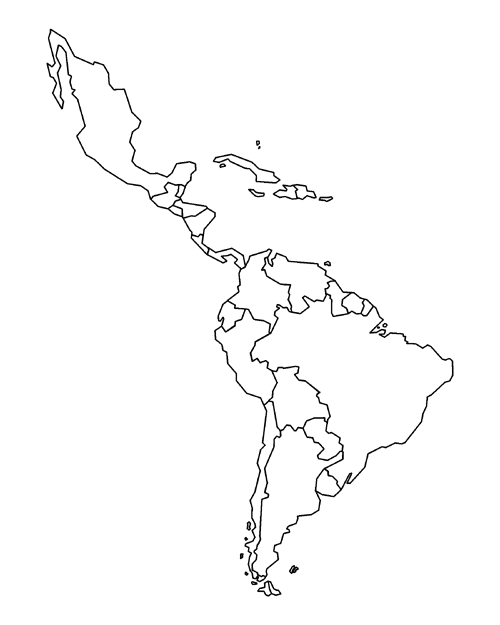
|
México:
Popocatepetl 19N 98W
Colima 19N 103W
Tacana 15N 92W
Guatemala
Pacaya 14.22N 90.36W
Fuego 14.28N 90.52W
Acatenango 14.30N 90.52W
Nicaragua
Cerro Negro 12.30N 86.46W
San Cristóbal 12.42N 87.00W
Masaya 11.59N 86.09W
Costa
Rica
Turrialba 10.01N 83.46W
Poás. 10.12N 85.09W
Miravalles. 10.44N 85.09W
Panamá
Barú 08.48N 82.33W
La Yeguada 08.31N 80.54W
El Salvador
Ylopango 13.40N 89.03W
San Miguel 13.25N 88.16W
Santa Ana 13.51N 89.37W
|
Colombia
Galeras 01.13N 77.22W
Huila 02.55N 76.03W
Ruíz 04.53N 75.19W
Ecuador
Guagua Pichincha 00.10S 78.35W
Tunguragua 01.28S 78.26W
Cotopaxi 00.40S 78.26W
Perú
El Misti 16 S 71.24W
Yucamane 17 S 70 W
Chile
Lonquimay 38.22 S 71.34 W
Llaima 38.41 S 71.43 W
Osorno 41.06 S 72.29 W
Hudson 45.54 S 72.58 W
Llullaillaco 24.43 S 68.31 W
Argentina
Aracar 24.16S 67.46W
|
|
References
Instituto Geofísico, Escuela Politécnica Nacional de Quito,
Ecuador
World Map of Volcanoes and Principal Aeronautical Features and Brochure
by Thomas J. Casadevall and Theodore B. Thompson (U.S. Department of the
Interior; U.S. Geological Survey)
USGS
Ecuadorciencia
Encyclopedia Britannica
For more information
please contact:
Jaquelina Michienzi, Senior Meteorologist, The Weather Channel Latin America,
TWCLA
Jmichienzi@weather.com
www.weather.com/espanol
|




